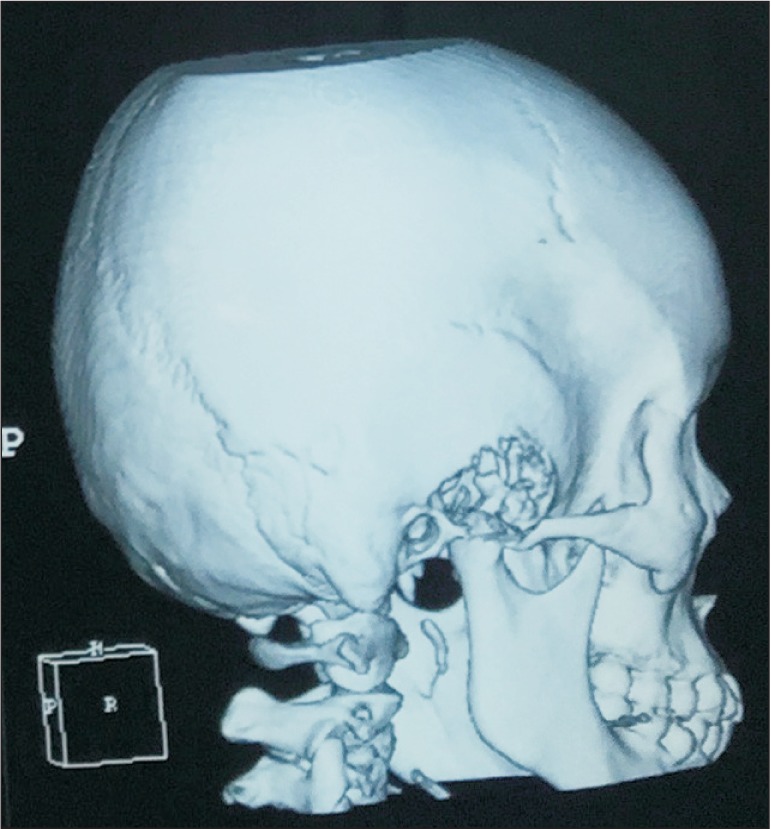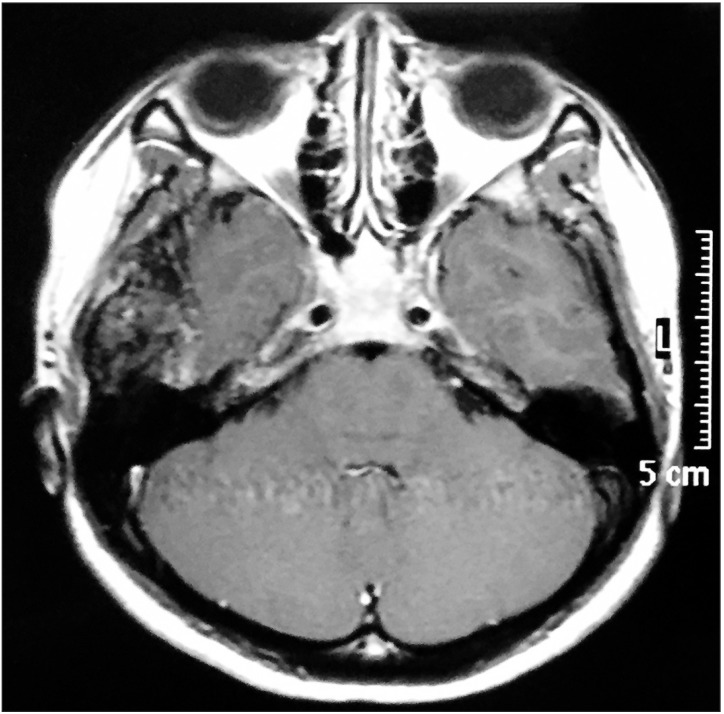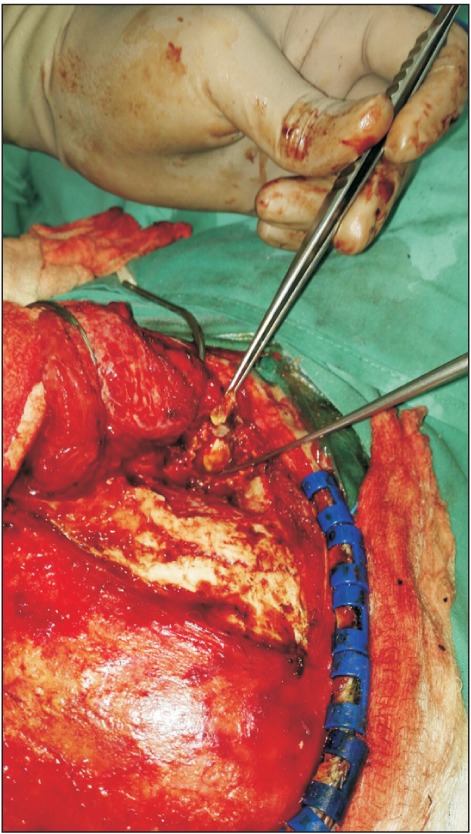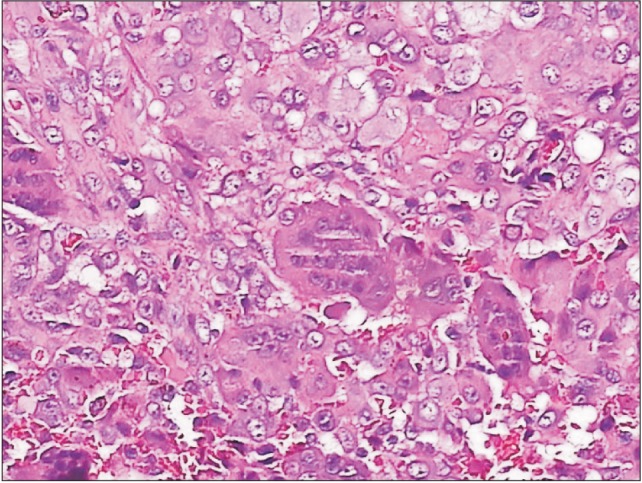J Korean Assoc Oral Maxillofac Surg.
2017 Apr;43(2):134-137. 10.5125/jkaoms.2017.43.2.134.
Giant cell tumor of temporomandibular joint masquerading as temporomandibular joint pain dysfunction syndrome: a rare case report
- Affiliations
-
- 1Department of Neurosurgery, Hospital Pulau Pinang, Pulau Penang, Malaysia. joeesam@gmail.com
- 2Department of Oral and Maxillofacial Surgery, Hospital Pulau Pinang, Pulau Penang, Malaysia.
- 3Department of Oral and Maxillofacial Surgery, Hospital Seberang Jaya, Pulau Penang, Malaysia.
- KMID: 2377018
- DOI: http://doi.org/10.5125/jkaoms.2017.43.2.134
Abstract
- Giant cell tumor (GCT) of the craniofacial bones has been reported but they are not common. This tumor occurs more often in women than in men and predominantly affects patients around the third to fifth decade of life. GCTs are generally benign but can be locally aggressive as well. We report a case of GCT involving the temporomandibular joint (TMJ), which was initially thought to be temporomandibular disorder (TMD). A 22-year-old female presented with swelling and pain over the right temporal region for 18 months associated with jaw locking and clicking sounds. On examination, her jaw deviated to the right during opening and there was a 2×2 cm swelling over the right temporal region. Despite routine treatment for TMD, the swelling increased in size. Computed tomography and magnetic resonance imaging of the brain and TMJ revealed an erosive tumor of the temporal bone involving the TMJ which was displacing the temporal lobe. Surgical excision was done and the tumor removed completely. Histopathological examination was consistent with a GCT. No clinical or radiological recurrence was detected 10 months post-surgery.
Keyword
MeSH Terms
Figure
Reference
-
1. Unni KK. Dahlin's bone tumors: general aspects and data on 11,087 cases. 5th ed. Philadelphia: Lippincott-Raven;1996. p. 263–285.2. Schajowicz F. Tumors and tumor-like lesions of bone: pathology, radiology, and treatment. 2nd ed. Berlin: Springer-Verlag;1994. p. 257–295.3. Bertoni F, Unni KK, Beabout JW, Ebersold MJ. Giant cell tumor of the skull. Cancer. 1992; 70:1124–1132. PMID: 1515987.
Article4. Zheng MH, Robbins P, Xu J, Huang L, Wood DJ, Papadimitriou JM. The histogenesis of giant cell tumour of bone: a model of interaction between neoplastic cells and osteoclasts. Histol Histopathol. 2001; 16:297–307. PMID: 11193206.5. Huvos AG. Bone tumors: diagnosis, treatment and prognosis. Tumors of histiocytic or fibrohistiocytic origin. 2nd ed. Philadelphia: Saunders;1991. p. 429–467.6. Robbins SL, Cotran RS, Kumar V. Robbins pathological basis of disease. 5th ed. Philadelphia: WB Saunders;1994. p. 1245–1246.7. Vanel D, Contesso G, Rebibo G, Zafrani B, Masselot J. Benign giant-cell tumours of bone with pulmonary metastases and favourable prognosis. Report on two cases and review of the literature. Skeletal Radiol. 1983; 10:221–226. PMID: 6648560.8. Leonard J, Gökden M, Kyriakos M, Derdeyn CP, Rich KM. Malignant giant-cell tumor of the parietal bone: case report and review of the literature. Neurosurgery. 2001; 48:424–429. PMID: 11220389.
Article9. Min BI, Park YW. A case of metastatic giant cell tumor arising in two-year old girl. J Korean Assoc Oral Maxillofac Surg. 1988; 14:82–87.10. Lee HJ, Lum C. Giant-cell tumor of the skull base. Neuroradiology. 1999; 41:305–307. PMID: 10344520.
Article11. Morriss-Kay GM. Derivation of the mammalian skull vault. J Anat. 2001; 199:143–151. PMID: 11523816.
Article12. Findlay JM, Chiasson D, Hudson AR, Chui M. Giant-cell tumor of the middle cranial fossa. Case report. J Neurosurg. 1987; 66:924–928. PMID: 3572521.13. Manfredini D, Guarda-Nardini L, Winocur E, Piccotti F, Ahlberg J, Lobbezoo F. Research diagnostic criteria for temporomandibular disorders: a systematic review of axis I epidemiologic findings. Oral Surg Oral Med Oral Pathol Oral Radiol Endod. 2011; 112:453–462. PMID: 21835653.
Article14. Lee BK. Evidence-based practice in the treatment of temporomandibular disorders. J Korean Assoc Oral Maxillofac Surg. 2012; 38:263.
Article15. Wang CS, Lou JH, Liao JS, Ding XY, Du LJ, Lu Y, et al. Recurrence in giant cell tumour of bone: imaging features and risk factors. Radiol Med. 2013; 118:456–464. PMID: 22872452.
Article16. Purohit S, Pardiwala DN. Imaging of giant cell tumor of bone. Indian J Orthop. 2007; 41:91–96. PMID: 21139758.
Article17. Wysocki RW, Soni E, Virkus WW, Scarborough MT, Leurgans SE, Gitelis S. Is intralesional treatment of giant cell tumor of the distal radius comparable to resection with respect to local control and functional outcome. Clin Orthop Relat Res. 2015; 473:706–715. PMID: 25472928.
Article18. Silvers AR, Som PM, Brandwein M, Chong JL, Shah D. The role of imaging in the diagnosis of giant cell tumor of the skull base. AJNR Am J Neuroradiol. 1996; 17:1392–1395. PMID: 8871731.
- Full Text Links
- Actions
-
Cited
- CITED
-
- Close
- Share
- Similar articles
-
- Tenosynovial Giant Cell Tumor of the Temporomandibular Joint
- The Study for Treatment fo Temporo-mandibular Joint Pain
- Villonodular Synovitis of the Temporomandibular Joint: A Case Report
- A study on simultation of the mandibular movement of the patients with temporomandibular joint disorder
- Autogenous auricular cartilage graft for repair of temporomandibular joint disk





